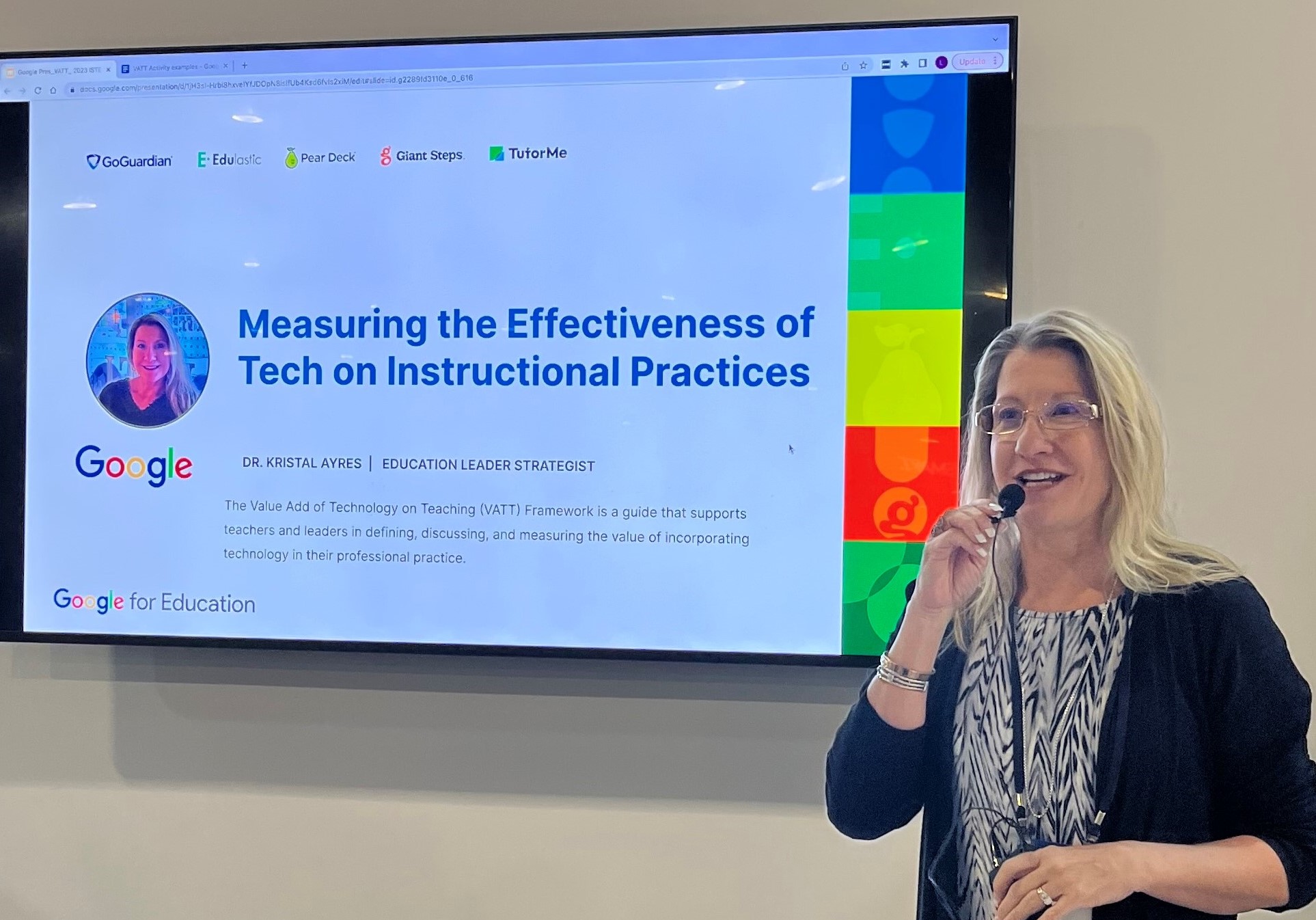The Potential Impact of AI on Edtech
The future of AI in the edtech sector, according to Dr. Kristal Ayres, Education Leader Strategist at Google for Education

The EdExec Summit is a new event from Tech & Learning that brings together senior executives from companies serving the K-12 industry for a three-day networking conference dedicated to the business of education. Summit presenter Dr. Kristal Ayres, Education Leader Strategist at Google for Education, discusses the future of AI in the edtech sector.
The Impact of AI in EdTech
“The potential impact of AI on the education market is significant,” says Ayres. “By automating tasks, providing personalized learning experiences, and creating new educational materials, AI has the potential to revolutionize the way we learn. We can expect to see even more innovative and impactful applications of AI in the education market.”
As is the case with many new tech developments, social media explodes with sensationalized examples—a commencement speech here, popular tech news outlet “staff written” AI-generated article series or Marvel title sequence there—but how soon will we see cutting-edge AI become commonplace?
“There are a number of factors that suggest that it could happen sooner rather than later. One factor is the rapid pace of development in AI research,” says Ayres. “In recent years, there have been major advances in areas such as machine learning, natural language processing, and computer vision. The cost of AI technology is also now decreasing, making it more affordable to adopt.”
The other factor, notes Ayres, is the increasing availability of information formerly difficult to obtain. A vast amount of new data is now accessible that can be used to train AI algorithms.
Pros and Cons of AI in the Classroom
”AI can be used to automate tasks that are time-consuming and repetitive, freeing teachers to focus on more creative and engaging activities,” says Ayres. “On the other hand, it is important to ensure that AI does not replace the human touch that is essential for effective teaching.”
Notable Pros:
Tools and ideas to transform education. Sign up below.
- Personalized Learning: By analyzing student data, AI can adapt the learning material to match the student's learning style, pace, and ability to maximize their learning potential.
- Efficiency: Institutions can automate administrative tasks, reducing the workload for staff so they can focus on delivering high-quality education to students.
- Accessibility: Students with disabilities can gain customized learning experience, while also reducing the cost of textbooks and other learning materials.
- Analyzing Student Data: AI can identify areas in which students struggle and provide real-time feedback for teachers to intervene promptly and help them improve performance.
- Adaptive Learning: Platforms can be created that adjust the difficulty of the material based on the student's progress can help students to stay challenged and engaged.
- Virtual Tutors: AI can potentially provide one-on-one instruction to students, and can be especially helpful for students who are learning at a different pace than their peers.
- Assessment: Tasks such as grading essays and providing feedback can be automated to free up teachers' time so that they can focus on providing individualized instruction.
- Curriculum Development: Curriculum content can be tailored to the needs of specific students or groups of students to help to ensure that all have access to high-quality educational materials.
Potential Cons:
- Interpretability: It can be difficult to understand how AI algorithms make decisions.
- Cost: Not all institutions can afford AI, which may create disparities in access to education and perpetuate existing inequalities.
- Dependence on Technology: Over-reliance on AI can have adverse effects on students' ability to learn independently and may hinder the development of critical thinking and problem-solving skills.
- Security and Privacy: If not adequately secured, data could be hacked, misused, or stolen.
- Bias: An AI system is only as good as the data on which it is trained. If the data is biased, the AI system will also be biased, perpetuating existing inequalities and discriminations.
AI—Boost Learning or Squash Creativity?
“The impact of AI on education is a complex and multifaceted issue. There is no doubt that AI has the potential to broaden the possibilities of learning,” says Ayres. “However, there is also a risk that AI could lead to a narrowing of perspective and a reduction in creativity and thought. We need to make sure that AI systems are not used to create echo chambers where people are only exposed to information that confirms their existing beliefs.”
Overall, the impact of AI on education is still uncertain. It is important to be aware of these potential risks so that we can mitigate them and ensure that AI is used for good.
3 Ways AI Can Help Teachers
- Generate lesson plans: AI could be used to generate lesson plans based on a teacher's curriculum and the needs of their students. This could save teachers a significant amount of time and effort.
- Create assessments: AI could be used to create assessments that are tailored to the needs of individual students. This could help teachers to provide more personalized instruction.
- Grade assignments: AI could be used to grade assignments, which could free up teachers' time so that they can focus on other tasks.
AI has the potential to be a powerful tool for teachers. By automating tasks and providing personalized learning experiences, AI can help teachers to save time and focus on more meaningful interactions with students.
How to Future-Proof AI Policies
- Establish a committee to oversee guidelines that includes a variety of stakeholders, such as teachers, administrators, parents, and students.
- Conduct research on AI in education to understand the benefits and risks of AI and develop appropriate policies.
- Consult experts in the field of AI for guidance on developing ethical and effective policies.
- Pilot test guidelines and policies in a small group of classrooms to identify potential problems and permit districts to make necessary revisions.
- Get feedback from stakeholders to ensure guidelines and policies meet the district’s needs.
Districts must be proactive, flexible, transparent, ethical, and inclusive to future proof their guidelines and policies about AI to ensure a seamless foray into this new world of technology.
To share your feedback and ideas on this article, consider joining our Tech & Learning online community here.
Sascha has nearly two decades of experience as a freelance journalist writing for national magazines, including The Washington Post, LA Times, Christian Science Monitor, National Geographic Traveler, and others. She writes about education, travel and culinary topics.

